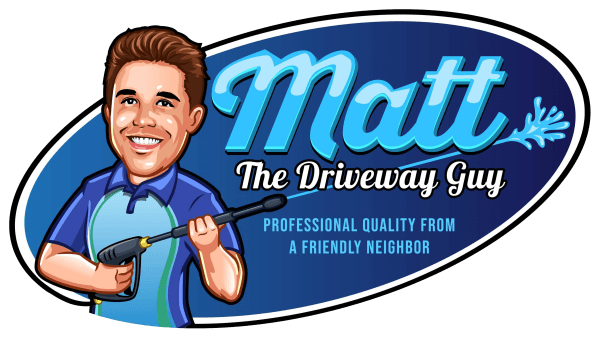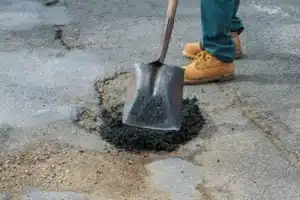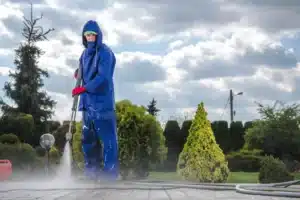Maintaining the appearance and structure of your home is crucial, and pressure washing plays a vital role in it. Whether spring, summer, fall, or winter, every season demands specific maintenance tasks for homeowners. Our Pressure Washing Checklist is designed to streamline your home’s exterior care and ensure that it shines throughout the year. This guide offers insider advice from Matt The Driveway Guy, a trusted Greenville, SC, area figure. Following our checklist, you can keep your home safe from the elements and expect a spotless, shiny, and safe exterior when you’re done reading this article.

Start By Taking These Safety Precautions
Before you start pressure washing, it’s crucial to consider safety. Pressure washers are powerful tools, and improper use can lead to injury or damage. Here are some safety tips to keep in mind:
- Read the Manual: Always read and understand the user manual of your pressure washer. Each model has specific instructions and safety precautions.
- Wear Protective Gear: Always wear protective gear, including safety goggles, gloves, ear protection, and closed-toe shoes. This gear protects you from high-pressure water streams and any debris dislodged during cleaning.
- Be Aware of Your Surroundings: Ensure that no one, especially children and pets, is around the area you are cleaning. Be mindful of your surroundings to avoid accidents.
- Check for Hazards: Before starting, check the area for electrical hazards, slippery surfaces, and loose objects that could become projectiles when hit by high-pressure water.
- Never Point the Nozzle at People or Pets: The high-pressure stream can cause serious injury, so never direct it at people or animals.
- Use the Right Settings: Use the correct pressure settings and nozzles for the cleaning surface. Incorrect settings can damage your property.
- Avoid Ladders: Pressure washing can create a recoil force, making it dangerous to use on a ladder. Use extensions or professional help for high areas.
- Stay Alert: Always be alert and focused when using a pressure washer. Avoid distractions to maintain control over the machine.
Following these safety guidelines will ensure a safe and effective pressure-washing experience.
Pre-Pressure Washing Preparations
Preparing the area before starting your pressure washing project is crucial for safety and efficiency. Here are some steps to follow:
- Remove Obstacles: Clear the area of furniture, toys, and other movable objects. This not only makes it easier to clean but also prevents objects from being damaged by the high-pressure water stream.
- Protect Sensitive Areas: Cover plants, electrical outlets, and light fixtures with plastic sheets or tarps to protect them from water and cleaning solutions.
- Close Windows and Doors: Ensure that all windows and doors are closed to prevent water from entering your home.
- Inspect the Surface: Check for any cracks, loose bricks, or damaged mortar on the surface to be cleaned. Pressure washing can worsen existing damage, so it’s important to repair these issues beforehand.
- Sweep Loose Debris: Sweep away loose debris like leaves, dirt, and pebbles from the surface for a more effective cleaning process.
By adequately preparing the area, you can avoid potential damage and ensure that your pressure washing is as effective as possible.
Choose the Right Pressure Washer
Choosing the right pressure washer is crucial for effective and safe cleaning. There are mainly two types of pressure washers available in the market – electric and gas-powered models. Electric models are generally quieter and require less maintenance, while gas-powered models are more powerful and suitable for heavy-duty tasks. You should also consider the PSI and GPM ratings of the pressure washer, as higher ratings mean more cleaning power but also increase the risk of damaging surfaces. Additionally, you should choose the appropriate nozzle selection for the pressure washer, as different nozzles are designed for specific cleaning tasks.
Portable units are lighter and easier to move, while stationary units are more powerful but less mobile. It’s always best to choose a pressure washer that matches your cleaning needs and the type of surfaces you will be cleaning around your home.
Prepare Your Detergents and Cleaning Solutions
Choosing the right cleaning solution is critical to enhance the effectiveness of pressure washing. It is important to select surface-specific and eco-friendly detergents that can safely clean surfaces without causing any damage. Apply the cleaning solution using a low-pressure setting, allow it to sit for a few minutes and rinse it thoroughly to prevent any residue. Using appropriate cleaning solutions can improve cleaning results and protect surfaces and the environment. Consider using biodegradable and environmentally friendly detergents to achieve better cleaning results. Thoroughly rinse off the cleaning solution with clean water to prevent any residue.
Pressure Washing Techniques
Effective pressure washing involves more than just spraying water. If done wrongly, it will be a waste of effort and time, and the target surface could get damaged. Use these techniques for different surfaces:
- Start from the Top: Begin at the highest point of the surface and work your way down to ensure consistent cleaning and prevent streaking.
- Maintain Distance: Keep the nozzle a safe distance from the surface. A distance of 12-16 inches is usually recommended, but this may vary based on the pressure and the surface type.
- Even Strokes: Use even, overlapping strokes to prevent streaks. Move the wand side to side or up and down, depending on the area.
- Adjust Pressure Accordingly: Use lower pressure for delicate surfaces like wood or shingles and higher pressure for robust surfaces like concrete.
Mastering these techniques will help you clean efficiently and avoid damage to your property.
How to Address Tough Stains and Mold
When addressing tough stains and mold during cleaning, giving them extra attention is often necessary. Start by pre-treating the affected area with a stain remover or a mold and mildew remover before using the pressure washer. To effectively remove these stubborn stains and mold without damaging the surface, it’s important to use a moderate pressure setting. A rotating nozzle can be particularly effective for tough stains, providing a more thorough clean than standard nozzles. However, if you encounter persistent problems, it’s advisable to consult a professional to avoid causing any damage. Properly tackling these challenging areas is crucial for preserving the integrity and appearance of your property.

Pressure Washing Windows and Delicate Surfaces
Extra care is paramount to avoid damage when pressure washing windows and other delicate surfaces. Use the lowest pressure setting to prevent harming glass or delicate paintwork. Opting for a wide-angle nozzle helps disperse water pressure more evenly, further reducing the risk of damage. Employ a gentle, consistent technique, ensuring you don’t linger too long in one spot, which can lead to cracking or peeling. For extremely delicate areas, consider hand washing as a safer alternative to pressure washing. The key to successfully cleaning these fragile parts of your home lies in using the proper technique and exercising caution throughout the process.
Post-Pressure Washing Care
After completing pressure washing, it’s important to follow a specific post-cleaning routine to ensure everything settles properly and maintains the condition of your home. Start by inspecting the area for any missed spots or sections that may require a touch-up. Allow the surfaces of your home to completely dry, which could take a day or more, depending on the material and weather conditions. During this time, it’s also vital to check the washed surfaces for any accidental damage that might need repairing. Finally, remember to carefully remove any protective coverings you placed over plants and electrical outlets. Adhering to this routine is essential for maintaining the quality and appearance of your home post-pressure washing.
DIY vs Professional Pressure Washing
Several factors need to be considered when deciding between DIY and professional pressure washing. DIY can be a feasible option if you’re comfortable and skilled in handling a pressure washer. However, for more complex projects or if you’re uncertain, it’s advisable to hire a professional. Cost-wise, DIY might save on labor, but the expenses of renting or buying equipment can add up, whereas professionals bring their own tools. DIY pressure washing requires a significant investment of time and physical effort, so if you’re short on time or prefer not to engage in strenuous labor, opting for a professional service is more suitable. Additionally, professionals typically have more experience, which often translates into higher-quality results, especially for challenging or large-scale projects. They are also trained to use the equipment safely, addressing any safety concerns. Carefully weighing these factors — skill level, cost, time and effort, and quality and safety — will guide you in choosing the best approach for your specific situation.
Seasonal Pressure Washing Tips
Pressure washing needs can vary with the seasons:
Spring
As the snow melts and the flowers bloom, it’s time to rejuvenate your home’s exterior with our spring pressure washing checklist. This season is about washing away winter’s remnants—a mix of debris and cold weather buildup. Target your siding, deck, and outdoor furniture for a clean start. We suggest a soft wash approach for delicate areas where high pressure could do harm, preserving both beauty and integrity.
Summer
The balmy months of summer mean more time spent outdoors, making clean decks, patios, and pools a must. Your summer checklist should include a thorough pressure wash of these high-traffic areas. Don’t overlook your windows—clean panes significantly enhance your home’s summer shine. Regular washing also prevents buildup that can cause wood to rot, saving your deck from premature repairs.
Fall
Autumn’s falling leaves and debris can be challenging, but a good pressure wash can prepare your home’s surfaces for winter. We suggest integrating pressure washing with gutter cleaning this season to ensure free-flowing drainage before the ice sets in. Checking off these tasks will minimize mold growth and wood rot, two common issues that arise from autumn’s damp conditions.
Winter
Winter pressure washing is all about preparation and protection, using a pressure washing system that can handle a cold-water mix. Focus on pathways and concrete areas that can become hazardous when slippery. In the chillier months, the work may be best left to a professional with the equipment and experience to do it right and prevent damage from freezing water.
Practice Regular Maintenance and Care
Regular maintenance is key to extending the life of your home’s exterior. This includes conducting regular inspections to check for signs of mold, mildew, and dirt buildup. For areas that tend to get dirty more frequently, spot cleaning is recommended. After pressure washing, it’s important to reapply sealants or paint as necessary to protect the surfaces. Additionally, scheduling pressure washing at least once or twice a year is crucial to maintain your home’s appearance and prevent long-term damage. Implementing this long-term care plan keeps your home looking great and helps avert costly repairs in the future.
Collaborate with the Pros: Choose Matt The Driveway Guy
Some jobs require a professional touch, even with a complete pressure washing checklist. Matt The Driveway Guy, offers a range of cleaning services, from soft wash to power wash techniques, ensuring each client’s home gets the care it deserves. For complex tasks or simply for the assurance of professional quality, reach out to Matt and his team. We will restore your home to a sparkling and pristine finish.
Final Thoughts
Adhering to a year-round pressure washing checklist keeps your home not just clean but also safe and well-maintained. Matt, The Driveway Guy, stands ready to assist with tasks that demand a professional standard. Our trademark, Professional Quality from a Friendly Neighbor, is more than just a slogan—it’s a promise to every homeowner in the Greenville, SC, area and environ. Transform your home with the careful touch of a local expert.






